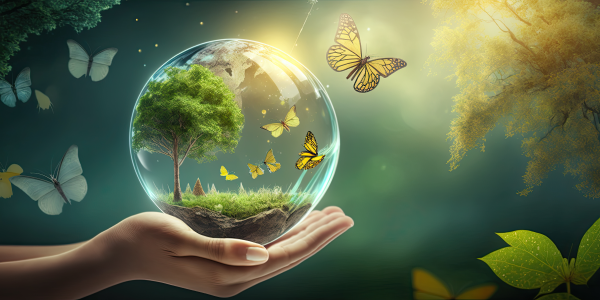Environmental sustainability is built on the principle that everything humans need for both survival and our well-being triggers a reaction in the environment. The pillars of sustainability are based upon the interdependent relationships of the environment, the economy, and our society. Because many of the goods and services that are required for human survival are either traded for or purchased monetarily, this inherently creates an impact on the environment. So, what is the economic impact of environmental sustainability?
In this second installment of our Environmental Sustainability blog series, we are exploring just that – how investing in the sustainability of your product line can have positive impacts on the environment.
For those not familiar with environmental sustainability, we're referring to the most responsible use of natural resources possible for a process while minimizing the impact of that process on our environment, with the general goal being to ensure that our successors still have plenty of resources themselves. As fellow colleagues in the industrial automation industry, a key role we should all adopt is towards considering reduction of waste, energy consumption and pollution as a fundamental part of any project or system.
Now you might have already been familiar with what environmental sustainability is and how it’s achieved, but have you considered how economic sustainability can impact the environment? Economical environmental sustainability is gained through setting standards and creating sustainable and efficient practices to meet those standards. Within your company, your standard or goal is might be similar to the following: to create a streamlined process for a valuable product that generates revenue. Now is the time to ask yourself, if you haven’t already: how do my company’s current standards for achieving this economic goal measure up in terms of environmental sustainability?
If you missed our first Environmental Sustainability blog post, we talked about how automation can have a positive impact on reducing waste in manufacturing. And, by reducing waste, the potential for economic sustainability benefits not only the environment but also profitability.
Another key area that is typically considered any time organization's think about environmental sustainability is energy conservation. The first step towards energy reduction is to measure and monitor the amount of energy you are using as granularly as possible for all aspects of a process. From there, you can more easily refine who, what, when, and where any energy spikes have occurred. With automated processes, energy input and output can be measured and optimized towards generating the same production levels at a reduce energy cost. Thus any resulting savings increases profits or can be reinvested in other areas of need to further optimize efficiency in the overall process. Or, with respect to the sometimes fluctuating cost of energy in some markets, it might be more economical to simply schedule downtime at certain times when the cost of energy is prohibitive to operating.

Considerations for Managing Resources for Future Generations
Sustainable practices help reduce the problem of humankind’s ever-growing ecological footprint. Having a smaller ecological footprint (many organizations these days have a target "net zero" goal for contributing zero carbon to our environment, for example), when adopted across enough people and organizations, should contribute towards there being enough natural resources left for future generations to benefit from. This starts with one organization and then another until the snowball effect kicks in. It's important for all of us to recognize that even small changes in the right direction, whether as individuals or as an organization, do make a difference. Cultivating sustainable practices to both improve economic growth and use less natural resources helps the bottom line for all of us in the now and for future generations to come.

There are many fiscal and economic benefits of environmental sustainability that you may not have considered. Investments in energy efficiency, green infrastructure, water and wastewater management, and efficient transportation are just a few possible options, many of which can be made with automated methods. The greatest success with such initiatives generally requires investment in a broad range of economic, social, and environmental innovations, as opposed to just a single focus.
Resource efficiency and conservation practices can offer substantial fiscal benefits for businesses, local agencies, and households alike (using fewer resources lowers input costs when the same output can be achieved with less). The fiscal “break-even point” for most sustainable investments is around five to eight years, meaning the environmental and social benefits can be felt immediately with return on that investment coming thereafter. And with energy generation being the second largest source of greenhouse gas emissions, efficient use of energy is a must. We can feel the strain of overuse of energy on our wallets both at home and at the workplace when the bill arrives! Thus, it’s important to ensure your software and operating systems are running on the latest, most efficient versions and on hardware that utilizes energy as efficiently as possible.
At Software Toolbox, we want to give our customers the ability to move from a reactionary “fail and fix” environment to a proactive “predict and prevent” environment which is almost always the more efficient option (machinery operating at less than 100% due to a defect over time can use more energy to do the same job or can result in subpar product quality leading to more castoffs and/or rework). This can be done through introducing specific environmental goals, such as predictive maintenance.
The ability to operate with predictive maintenance (such as detecting bearing damage in a machine and fixing it before it becomes problematic), rather than relying on manually executed scheduled maintenance, allows plant operators the ability to predict equipment health and identify potential downtimes and failures before they happen, keeping equipment operating at peak efficiency and output. We also know unplanned downtime and failures can negatively affect margins and budgets, so software maintenance is also optimal for the plant’s overall health and operating at peak efficiency. Our goal at Software Toolbox is to assist your operations such that they utilize the fewest resources possible and to help extend the life of your plant through products and a support team that you can trust to have your back.

How Support and Maintenance Aids Efficient Industrial Operations
One way of efficiently using resources is by maintaining your Software Support and Maintenance Agreement so that you are always running the latest software versions and have access to the latest bug fixes. As you know, maintaining your Support Agreement with Software Toolbox also allows you access to our amazing team of support engineers whenever an issue arises to help keep you running at the highest performance. We are always happy to help!
In terms of your agreement, the average cost of support/maintenance is around a 20% of the cost of a perpetual license (and for subscription users, it's included with the annual subscription renewal). For most of our users, it's a annuity towards peace of mind and having a trusted partner to help whenever there's a question or issue and it allows them to stay current and avoid any recently discovered bugs or security issues that could negatively impact the system.
Maintaining your support/maintenance agreement is also one way users invest in not only the software but in the sustainability of their processes, as well. This increases reliability and maintains or potentially improves performance, thus benefitting the bottom line! Renewing your Support and Maintenance agreement for another year provides the following benefits:
- The ability to upgrade your software as new versions are released.
- Access to the most current Windows OS support.
- Priority access to technical support for installation, configuration, optimization, and software related issues and concerns. Clients with active support program memberships receive priority for access to our experts when required for detailed optimization/analysis discussions and shared desktop sessions.
- Support is available by telephone, email, online, and as necessary online shared desktop interactions to ensure you get the most value from your investment in our software.
- Priority handling of license re-registration requests if your computer system hardware or OS fails and removal of the one license re-registration per year limit that applies to users without active support agreements.
At Software Toolbox, we strive to recommend solutions that reduce long-term liabilities through cost savings and lowered operating costs for our customers wherever possible. One way we do this is through access to our support team and an extensive knowledgebase with how-to literature, videos and more for the products we sell and support which, in the end, will save you time, money, and energy. We aim for less water, land, material usage by being your “One Responsible Partner” presenting options towards less costs in the long run, within that five to eight year financial turnaround time.
For more information on the Support and Maintenance Agreements at Software Toolbox, please visit this page and please feel free to contact our support team with any questions and remember to subscribe to our blog for more posts on sustainability, best practices and other industrial automation topics and how-tos.




